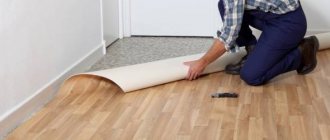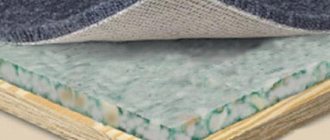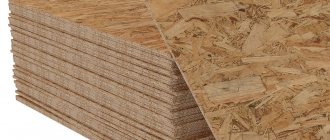Underlayment refers to a special material that is additionally used in the process of laying linoleum. Disputes regarding its necessity do not stop to this day, and therefore in this material we will tell you what kind of linoleum substrate there is, why it is needed and how it is installed.
Do you need a backing for linoleum?
On a note! The modern market offers several types of substrates with different densities, and it will not be easy for a beginner to make the right choice. Therefore, it is imperative to familiarize yourself with the existing types of material.
About the need for underlayment under linoleum
So, craftsmen have been arguing about the need for a substrate for quite a long time. Some claim that it is really needed, while others, on the contrary, consider it a waste of money and effort.
The debate about whether a backing is needed for linoleum continues to this day.
In reality, it is impossible to answer this question unambiguously , because there are situations when it is impossible to lay a floor covering without an insulating substrate, and sometimes this stage is skipped altogether. In any case, before deciding whether a foundation is needed, you need to become familiar with the main functions it performs.
What are the sizes of linoleum
- Soundproofing . This function is especially relevant for residents of city apartments, since a high-quality substrate can protect against noise coming from neighbors below.
- Thermal insulation . The function will be especially useful if the apartment is located above an unheated room or on the ground floor.
- Additional leveling of the rough base . The concrete floor, which usually has various cracks, protrusions and other defects, will not come into contact with the linoleum, so they (the defects) will not be noticeable. In addition, due to such depressions, linoleum can wear out faster.
The additional layer protects against sounds from the neighboring apartment and serves as floor insulation
What types of substrates are there?
Substrates are made from different materials, both artificial and natural. In order to choose the right option, familiarize yourself with the available types of foundations, study their advantages and disadvantages.
It is important to choose the right substrate
On a note! Today you can buy linoleum that already comes with a multi-layer lining; In this case, there is no need to lay additional substrate.
Cork backing
It consists of pressed wood fibers, does not contain additional additives, and therefore is environmentally safe. This type of underlay is often used for concrete floors because:
- has a long service life (about 28 years);
- can be used in any premises, regardless of their purpose;
- has good soundproofing characteristics.
Cork sheet backing
The substrate is sold in rolls 1 m wide, and therefore is easy to transport and install. There are several types with different thicknesses (ranging from 2.5-9 mm). The denser it is, the softer the floor will be and the worse the performance characteristics will be.
As for the disadvantages, in this case they are the following:
- high price . One roll will cost 1500-8500 rubles, that is, the substrate is often more expensive than the linoleum itself;
- Unsightly dents will appear under heavy objects over time , so rearranging always means replacing the substrate.
Cork backing
Note! On a damp floor, it is better to lay a base with a foil layer, which provides additional thermal insulation, although it is somewhat more expensive.
Jute backing
Another material of natural origin, which has a number of advantages.
- Cheap . A roll 10 m long costs about 1100-1400 rubles, that is, the jute base is much cheaper than the cork base.
- Hardness _ The material will retain its original shape even if heavy furniture is placed on it.
- Availability of several types of substrates with different densities.
- Long service life . The material can last more than 70 years - longer than linoleum itself (in case of replacement of the coating, such a substrate is not dismantled).
- Fire and moisture resistance . The material does not burn and has good protection against moisture.
Jute backing
There is only one minus: if there are dents on the subfloor, they will definitely appear over time.
Linen backing
Outwardly similar to jute, but differs in such advantages.
- Environmental friendliness . This material is natural; no adhesive components are used in its production.
- Affordable price . 10 sq. m of material will cost about 1000 rubles.
- Soundproofing . This type of substrate is less durable than jute, but has good soundproofing properties.
- Various thicknesses (2.5-6 mm) . Typically, 4 mm thick material does an excellent job of masking defects.
- Air permeability . This minimizes the risk of fungal development.
Linen backing
As for the downsides, there are practically none. The only exception is that the substrate is sometimes difficult to find in stores due to low production volumes. In addition, it is not very popular in Russia.
PET substrate
An artificial material with its own advantages.
- Low cost . This option is the cheapest of all existing ones, it costs approximately 25-30 rubles. for 1 sq. m.
- A large assortment . The substrate is sold not only in rolls, but also in panels (the second option is denser, so it is better to use it).
- Availability . The material can be purchased at any hardware store.
Polyethylene backing
But there are also disadvantages that you also need to be aware of.
- Short service life . After only 4 years, the base will become unusable and will have to be replaced.
- Impervious to air . Consequently, fungus will develop under the floor covering. As you can see, it is better not to buy such a substrate, regardless of its cheapness.
NPE based substrate
Combined substrate
It combines wool, jute and linen, thanks to which it received such advantages.
- Excellent thermal insulation . This is ensured mainly by the presence of natural wool.
- Affordable price . For 1 sq. m need to pay about 180 rubles.
- Strength, durability . The material can last up to 45 years, withstanding almost any load.
Combined substrate
But there are also disadvantages - this is, first of all, a large number of low-quality products on the market, outwardly practically indistinguishable from the original.
Coniferous substrate
Made from pressed coniferous fibers, it has excellent heat and sound insulation qualities. It also contains pine resin, and therefore prevents the development of fungus. The disadvantages include deformation some time after installation, as well as the characteristic smell of pine needles in the room, which, however, disappears after a few days.
Coniferous substrate
Composite substrate
The material is of synthetic origin - a double layer of PET, in the middle of which there are granules. Thanks to this, the substrate acquires good heat and sound insulation characteristics.
Composite
Prices for substrate from Tuplex
backing for Tuplex linoleum
What about particle boards?
Quite often, a chipboard base is used as a substrate, because its surface, strong and uniform, does not deform under loads. You can additionally lay a soft substrate on top of such material.
Table. Main types of particle boards.
| Name | Short description |
| Plywood | It is quite often used as a base for linoleum. It has a multi-layer structure, and therefore does not change shape under loads. But it is quite expensive. |
| OSB | Sufficiently thick (up to 1 cm) material, allowing you to get an even rough base. In this case, OSB boards can delaminate due to heavy loads, which, in turn, leads to the appearance of unevenness on the floor. |
| Fiberboard | The thickness is only 1.8 mm, and therefore if the base is very uneven, the material is not used (otherwise the linoleum will be deformed). |
Chipboards are allowed to be used when installing linoleum
On a note! With prolonged contact with moisture, wood tends to swell, so it is better not to use such a base in a bathroom or other damp room. Even without proper treatment, mold develops on the slabs.
Surface quality requirements
Before laying the substrate for laying linoleum, regardless of the material, it is necessary that the requirements for the main surface are met:
- The floor must be level.
- It is necessary to remove all debris and dust; it is better to manipulate it with a vacuum cleaner, otherwise you will feel garbage afterwards.
- If the backing material sticks to the glue, you need to clean the surface of the old paint.
- The base must be dry to avoid material decay and rotting. This condition is especially true for wooden floors.
- There should be no greasy stains or oil marks on the base of the floor.
When is a substrate needed and not needed?
Here are the main situations in which the use of a substrate is necessary:
- damp floor . If your apartment is located above a non-residential premises or on the ground floor, then the underlay will protect it from dampness. In this case, it is not worth saving, and it is better to give preference to natural materials;
The underlay is laid in the presence of dampness or floor defects
- thin linoleum . It is inexpensive, but it highlights all the shortcomings and does not have thermal insulation properties;
- uneven subfloor . If it is not possible to level it, a structural substrate will help hide unevenness.
But in some cases it is quite possible to do without an additional substrate.
- If the linoleum is dense , if it already has a jute or cork backing.
- If linoleum is laid on top of an old floor covering . In this case, it is important that the floor does not have any defects; otherwise, dismantling of the material is required.
Polyvinyl chloride linoleum
Old linoleum flooring
This becomes possible when the old material is firmly attached to the floor and has no unevenness, torn areas, or deformations. Then you can safely lay a new covering on it. Immediately before flooring, it is necessary to apply glue to the old surface and degrease it. If the expired coating does not meet the presented requirements, then it is unsuitable for the role of a substrate.
Important points about floor insulation
When choosing a material to be used as a substrate, give preference to high-quality and reliable products, as this will increase the service life of linoleum. After all, some materials, as we have already found out, have a longer service life than the mentioned floor covering.
With a high-quality backing, linoleum will last longer
On a note! In order for the service life of linoleum to be maximum, the density of the selected substrate must be at least 730 g per 1 square meter. m.
Main characteristics
The use of needles and coniferous wood in the production of the substrate gives the material many positive properties:
- high damping characteristics that allow you to dampen any floor vibrations;
- leveling differences in base height without any extra time;
- high degree of elasticity, which allows you to protect the locking connections of the lamellas from destruction for many years;
- the operational service life of the substrate, as the manufacturer assures, is not just equal to that of laminate or parquet, but exceeds it by 1.5 and even 2 times;
- low level of thermal conductivity, which allows you to retain heat in rooms without any additional insulation measures;
- good noise and sound insulation.
These positive characteristics have made coniferous underlayment popular when installing laminate or parquet floors.
Step-by-step guide to laying underlayment
Step 1. First of all, you have to level the base, so first clean it of dirt and debris remaining after dismantling work. Then treat the floor with a primer, adding an antifungal agent to it (all damage must be carefully treated).
Next, level the base with a screed. If there are depressions, cover them with cement mortar, adding PVA glue to it (this will prevent cracks from appearing again). You can also use adhesive designed for laying ceramic tiles.
Preparing the subfloor
Step 2. Lay a waterproofing layer, which is required for very damp surfaces. Take the PET film and spread it over the concrete base. It is advisable to use a large canvas so as not to connect individual parts of the material. When using multiple strips, secure them with adhesive tape.
The film is not fixed to the floor surface; this occurs by laying subsequent layers
Step 3. Lay down the previously selected substrate. Proceed carefully, seal the joints between the sheets with the same adhesive tape. Make sure that the substrate is laid evenly, without creases, “bubbles” and other defects. Also pay attention to the joints - they should remain invisible, otherwise they will soon appear through the thin linoleum.
We lay insulation on the concrete floor
Step 4. After this, fix the underlay to the floor. Usually double-sided tape is used for this, but if you don’t have it, you can use glue. Select the specific type of glue depending on the material used, but in any case it should be polyurethane.
Glue the backing to the surface
On a note! After laying the backing, wait a few hours for the glue to set. Only after this can you start laying the linoleum itself.
Video - How to lay roll underlay
Rules for laying linoleum
Usually, when laying linoleum, water-dispersed glue is used. It is applied to the laid substrate with a notched trowel, then, after a few minutes (when the chemical reaction occurs), the flooring sheets are glued. Read more about laying linoleum in this article.
Stages of laying linoleum
The nuances of joining the canvases. What do you need to know?
If you need to join parts of linoleum, then the individual sheets must be laid close together, according to the drawing on them, so that in the end there are no gaps.
Connecting linoleum sheets
The gaps between the pieces of linoleum are masked as follows: first, the edges are thoroughly wiped off from dust, after which double-sided adhesive tape is glued to the back side. It is also recommended to cold weld the joints.
Cold welding with application needle
Cold welding of linoleum - stages of work
Note! There is a special apparatus with which the sheets are joined using the hot welding method. In this case, very reliable connections are obtained, but it is worth remembering that such seams will be noticeable, which means they can ruin the appearance of the coating.
Hot welding of linoleum
Hot welding of linoleum in stages
Video - Rules for laying linoleum on a crooked floor
Wooden base
The covering should not have damaged boards. It is necessary to check that there are no protruding heads from nails or screws.
Before laying linoleum, it is necessary to check the condition of the floor
Especially if the owners are going to put linoleum on the old floor.
You should inspect carefully for any cracks, irregularities, or crevices. If available, then place special plywood on top, 8–12 cm thick. In this case, there is no need for a backing; sheets of plywood act as backing material.
However, experienced builders do not advise laying linoleum on top of fiberboard; this situation can be explained simply; such a material has a low resistance to moisture and temperature changes; this situation often leads to further deformation.
Some useful tips
To properly install underlayment and linoleum, follow some important guidelines.
- When buying a substrate, check it for rigidity - press on it, and if dents eventually appear on it, then it is better to refuse the purchase. Give preference to quality products from trusted manufacturers.
- Do not level the floor with gypsum putty, as it will quickly peel off in high humidity. Also, plaster will not withstand the loads from massive furniture.
- After filling the screed, wait 28-30 days for it to dry thoroughly, and only then proceed to further work.
- Remove traces of detergents (if any) remaining after preparing the base.
You need to do the work slowly and according to technology, so as not to be upset later due to defects that appear
Prices for IVC linoleum
Linoleum IVC
Concrete base
The best option is a cement-sand screed that levels the mixture, as it is also called a “flat floor.” It is necessary to allow the concrete to dry before laying the coating. Drying time depends on room temperature, humidity level and ventilation quality. But not less than 30 days.
It is easy to check the screed for moisture using plastic film. You need to put cellophane on top of the concrete overnight and secure it with tape. If the film remains dry the next morning, it means that you can begin laying the substrate. Be sure to clean it from dust.











